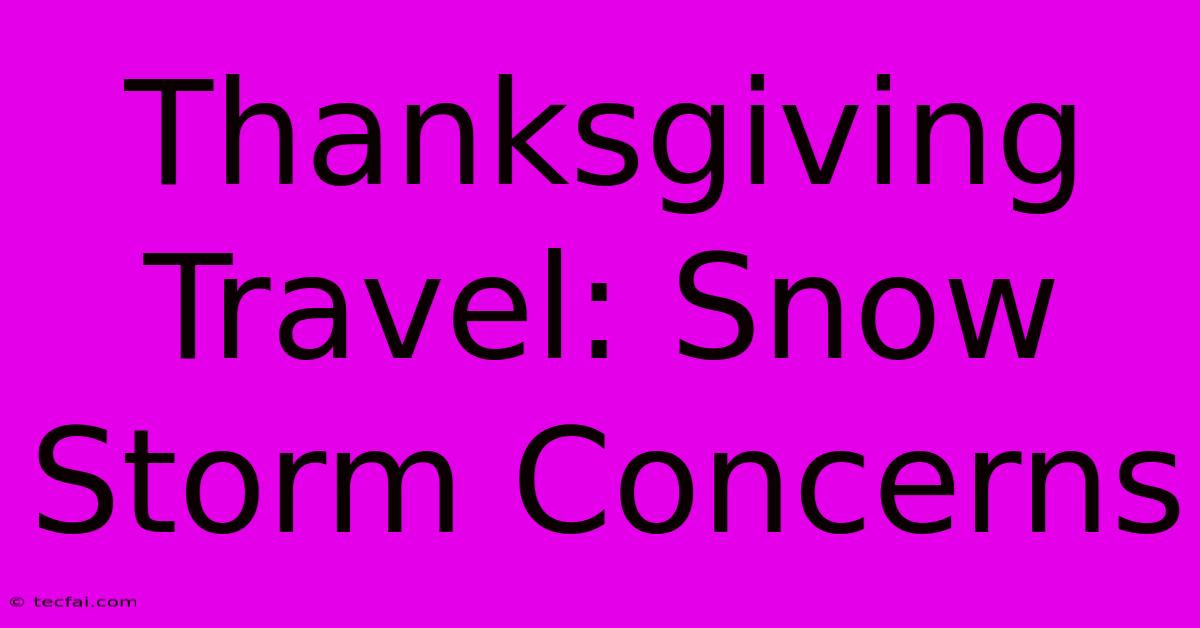Thanksgiving Travel: Snow Storm Concerns

Discover more detailed and exciting information on our website. Click the link below to start your adventure: Visit Best Website tecfai.com. Don't miss out!
Table of Contents
Thanksgiving Travel: Snow Storm Concerns
Thanksgiving is a time for family, feasting, and… potential travel nightmares. With millions hitting the roads and skies for the holiday, the risk of encountering a disruptive snowstorm is a very real concern. This year, don't let a blizzard ruin your Thanksgiving plans. Let's delve into how to prepare for and mitigate the impact of unexpected winter weather on your Thanksgiving travel.
Assessing the Risk: Monitoring Weather Forecasts
The first step in combating snowstorm anxieties is proactive monitoring. Don't just glance at a quick weather app; dedicate time to understanding the specifics. Utilize reputable sources like the National Weather Service (NWS) and other meteorological agencies for detailed forecasts. Pay close attention to:
- Timing: When is the storm predicted to hit? Will it impact your departure or arrival?
- Intensity: How severe is the storm predicted to be? Are we talking light flurries or blizzard conditions?
- Location: Precisely where will the heaviest snowfall occur? Will it directly impact your route?
Understanding these factors allows you to make informed decisions well in advance, potentially adjusting your travel plans accordingly.
Pre-Trip Preparations: Packing for the Unexpected
Packing for a potential snowstorm is crucial. Don't assume everything will be fine; prepare for the worst-case scenario:
- Emergency Kit: Include blankets, extra warm clothing (hats, gloves, scarves), non-perishable food, water, a first-aid kit, a flashlight, and extra batteries.
- Vehicle Preparedness: Ensure your car is winter-ready. This includes checking tire pressure, having sufficient antifreeze, and having a full tank of gas. Consider carrying tire chains if traveling in mountainous or particularly snowy regions.
- Communication Plan: Inform family and friends of your itinerary, including departure and arrival times, and check in regularly during your journey. Ensure your phone is fully charged.
On-the-Road Strategies: Navigating Winter Conditions
If you encounter snowy conditions while traveling, prioritize safety:
- Reduce Speed: Drive significantly slower than usual, increasing following distance to allow for increased braking time.
- Smooth Movements: Avoid sudden braking or acceleration, which can cause skidding.
- Awareness: Stay alert and aware of your surroundings. Be cautious of black ice, which is nearly invisible.
- Pull Over: If visibility becomes extremely poor, pull over to a safe location and wait for conditions to improve. Avoid stopping on the shoulder of busy highways.
Alternative Travel Options: Considering Your Choices
If severe weather is predicted, consider alternative travel options:
- Postponement: The most straightforward solution might be to postpone your trip until the storm passes.
- Alternative Transportation: If flying, check with your airline for potential delays or cancellations. Consider train travel if it's an option for your route.
- Flexibility: Remain flexible and adaptable. Unexpected delays are possible, so having a backup plan is crucial.
Post-Trip Considerations: Staying Safe After Arrival
After arriving at your destination, ensure you're still safe and warm. Check in with loved ones to let them know you've reached your destination safely.
Thanksgiving travel during a snowstorm presents challenges, but with careful planning and preparedness, you can significantly reduce the risks and ensure a safe and enjoyable holiday. Remember, safety always comes first. Don't hesitate to adjust your plans if necessary to avoid hazardous conditions. Happy Thanksgiving travels!

Thank you for visiting our website wich cover about Thanksgiving Travel: Snow Storm Concerns. We hope the information provided has been useful to you. Feel free to contact us if you have any questions or need further assistance. See you next time and dont miss to bookmark.
Featured Posts
-
2024 Nba Celtics Vs Timberwolves Odds
Nov 26, 2024
-
Yellen Faces Tough Treasury Tasks
Nov 26, 2024
-
Assisted Dying Bill Hindu Sikh Concerns
Nov 26, 2024
-
Tractor In Tenbury Wells Flood Footage
Nov 26, 2024
-
Severe Flu 8 Risk Factors Explained
Nov 26, 2024
